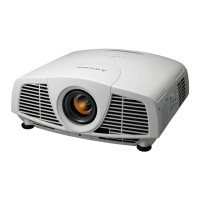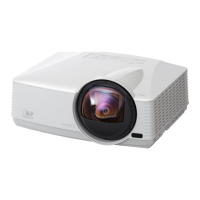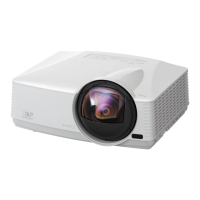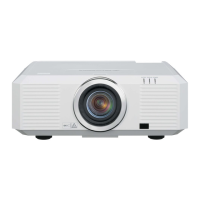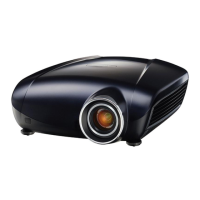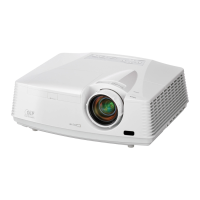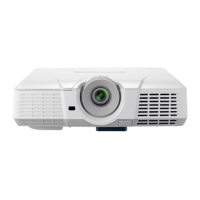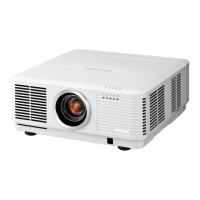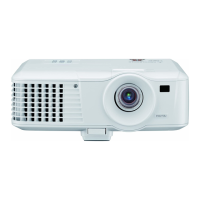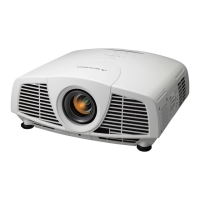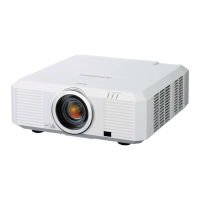What does the mark mean on my Mitsubishi WD570U Projector?
- NnsanchezSep 10, 2025
The appearance of the mark on your Mitsubishi Projector indicates that ineffective operation is being carried out; this is not a product malfunction.
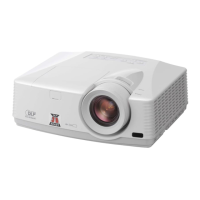
What does the mark mean on my Mitsubishi WD570U Projector?
The appearance of the mark on your Mitsubishi Projector indicates that ineffective operation is being carried out; this is not a product malfunction.
Why doesn't the remote control work well with my Mitsubishi WD570U Projector?
If the remote control for your Mitsubishi Projector isn’t functioning well, check that the batteries are loaded correctly and are not weak. Also, ensure that the remote control sensor isn't exposed to direct sunlight or fluorescent light. Use the remote control within its operation range, at least 2 cm away from the projector.
Why do the fans sound during standby on my Mitsubishi WD570U?
If the fans on your Mitsubishi Projector sound during standby, it's because when Standby Mode in the Installation menu is set to LAN Speaker Out or Monitor Out, the fans rotate at a very low speed to cool down the projector operating various functions. This is normal and not a malfunction.
What causes abnormal sounds from my Mitsubishi WD570U?
Abnormal sounds from your Mitsubishi Projector may occur because the color wheel spins at a high speed, which can produce metallic sounds in rare occasions. This is not a malfunction.
| Projection distance | - m |
|---|---|
| Vertical scan range | 50 - 120 Hz |
| Horizontal scan range | 15 - 105 kHz |
| Projection technology | DLP |
| Contrast ratio (typical) | 3000:1 |
| Screen size compatibility | 40 - 300 \ |
| Projector native resolution | WXGA (1280x800) |
| Aspect ratio | - |
| Compatibility | PC/MAC Compatibility |
| Dimensions (WxDxH) | 259 x 111.76 x 325.12 mm |
| Focus | Manual |
| Zoom capability | Yes |
| Focal length range | - mm |
| HDCP | No |
| Noise level | 33 dB |
| Noise level (economic mode) | 28 dB |
| Dot clock scanning frequency | 165 MHz |
| Service life of light source | 3000 h |
| Service life of light source (economic mode) | 6000 h |
| Serial interface type | RS-232 |
| USB 2.0 ports quantity | USB 2.0 ports have a data transmission speed of 480 Mbps, and are backwards compatible with USB 1.1 ports. You can connect all kinds of peripheral devices to them. |
| Supported video modes | 1080i, 1080p, 480i, 480p, 576i, 576p, 720i, 720p |
| Analog signal format system | NTSC 4.43, PAL, SECAM B |
| Product color | White |
| Power source | AC |
| AC input voltage | 100 - 240 V |
| AC input frequency | 50 - 60 Hz |
| Power consumption (standby) | - W |
| Power consumption (typical) | 340 W |
| Weight | 3810.18 g |
|---|
Specifies environmental conditions for projector placement to ensure safety and performance.
Describes the components and functions of the projector's remote control.
Instructions for inserting and replacing batteries in the remote control.
Provides projection distance and image size data for specific projector models.
Details installation based on screen aspect ratios (4:3, 16:10, 16:9).
Explains ceiling and rear projection installation methods.
Guides connecting projectors to VCRs, video cameras, and other AV equipment.
Details connecting equipment with an HDMI terminal for video and audio input.
Explains connecting projectors to computers via Mini D-SUB or other interfaces.
Covers initial setup steps like connecting power and removing the lens cap.
Describes how to adjust the projector's angle for optimal projection.
Step-by-step guide for turning the projector on and off safely.
Adjusts image position and audio output volume from the projector's speaker.
Changes aspect ratio and provides instructions for enjoying 3D content.
Explains the general procedure for navigating and using the projector's menus.
Adjusts image quality settings like brightness, contrast, color, sharpness, and tint.
Configures signal input settings and manages audio input/volume.
Configures installation, general options, and displays projector status information.
Sets up network connectivity, projector name, and IP configuration.
Fine-tunes image brightness, contrast, color temperature, and tint.
Controls image clarity and adjusts individual color tones (R, G, B, etc.).
Adjusts computer images and applies a filter to reduce noise.
Assigns a name and configures network certification for the projector.
Configures network IP address, subnet mask, gateway, and DHCP settings.
Sets up wireless network connection parameters like SSID and encryption.
Projects computer images directly via a USB connection without drivers.
Projects computer images over LAN, supporting remote desktop and multi-computer display.
Projects images/presentations directly from USB memory without a PC.
Sets custom startup images and uses freeze/magnify functions for viewing.
Enables a password to prevent unauthorized operation or access.
Supervises and controls the projector via a LAN network using specific software.
Step-by-step guides for replacing the projector lamp and resetting its operation time.
Guidance on when to replace the projector lamp based on usage hours and indicators.
Solves problems related to power, no image, or incorrect image display.
Addresses image quality issues and other operational problems like noise or remote control issues.
Procedures for cleaning the projector, lens, and general maintenance warnings.
Explains the meaning of projector indicator lights and their corresponding troubleshooting steps.
Details the types and pin configurations of connectors and lists included accessories.
Provides detailed compatibility information for RGB signals and resolutions.
